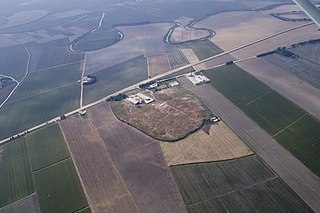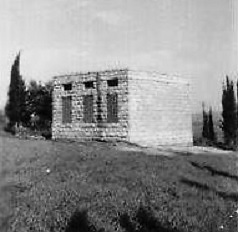
Tell Ta'yinat is a low-lying ancient tell on the east bank at the bend of the Orontes River where it flows through the Amuq valley, in the Hatay province of southeastern Turkey about 25 kilometers south east of Antakya, and lies near Tell Atchana, the site of the ancient city of Alalakh. Tell Ta'yinat has been proposed as the site of Alalaḫu, inhabited in late 3rd millennium BC, mentioned in Ebla's Palace G archive; and in later times as Kinalua, the capital city of an Iron Age Neo-Hittite kingdom.
Hamoukar is a large archaeological site located in the Jazira region of northeastern Syria, near the Iraqi and Turkish borders. The early settlement dates back to the 5th millennium BCE, and it existed simultaneously with the Ubaid and the early Uruk cultures. It was a big centre of obsidian production. In the 3rd millennium, this was one of the largest cities of Northern Mesopotamia, and extended to 105 ha.
Tell Arbid is an ancient Near East archaeological site in the Khabur River Basin region of Al-Hasakah Governorate, Syria, about 50 kilometers north northeast of modern Al-Hasakah. It is located 45 kilometers south of Tell Mozan, the site of ancient Urkesh and about 15 kilometers from the site of Chagar Bazar. The Halafian site of Tell Arbid Abyad is a short distance away.

Abu Zurayq is an archaeological site located on the western edge of the Jezreel Valley and its transition to the Menashe Heights, next to Highway 66, between the modern kibbutzim of HaZore'a and Mishmar HaEmek.

Tell Qaramel is a tell, or archaeological mound, located in the north of present-day Syria, 25 km north of Aleppo and about 65 km south of the Taurus mountains, adjacent to the river Quweiq that flows to Aleppo.

Tell Sabi Abyad is an archaeological site in the Balikh River valley in northern Syria. It lies about 2 kilometers south of Tell Hammam et-Turkman.The site consists of four prehistoric mounds that are numbered Tell Sabi Abyad I to IV. Extensive excavations showed that these sites were inhabited already around 7500 to 5500 BC, although not always at the same time; the settlement shifted back and forth among these four sites.
Tell Sukas is a Late Bronze Age archaeological mound on the Eastern Mediterranean coast about 6 kilometres (3.7 mi) south of Jableh, Syria.
Tell Judaidah is an archaeological site in south-eastern Turkey, in the Hatay province. It is one of the largest excavated ancient sites in the Amuq valley, in the plain of Antioch. Settlement at this site ranges from the Neolithic through the Byzantine Period.

The Birecik Dam Cemetery is an Early Bronze Age cemetery in the Gaziantep region in southeastern Turkey. This cemetery was used extensively for a very short period of time at the beginning of the third millennium BC.

Tell Taban is an archaeological site in north-eastern Syria in the Al-Hasakah Governorate. It is the site of the ancient city of Ṭābetu.

Yarim Tepe is an archaeological site of an early farming settlement that goes back to about 6000 BC. It is located in the Sinjar valley some 7km southwest from the town of Tal Afar in northern Iraq. The site consists of several hills reflecting the development of the Hassuna culture, and then of the Halaf and Ubaid cultures.
Bahra 1 is an archaeological site in the Subiya region on the coast of Kuwait Bay (Kuwait) associated with the Ubaid culture. It is one of the earliest Ubaid culture settlements in the Persian Gulf region, about 5500–4900 BC.
Tell Djassa is an archaeological site in Syria, in the Khabur River basin, in the area of the Khabur Triangle in Upper Mesopotamia.
Tell Abu Hafur is an archaeological site in Syria, in the Khabur River basin, in the area of the Khabur Triangle in Upper Mesopotamia.
Tell Saadiya is a tell, or archaeological settlement mound, in Diyala Governorate (Iraq).
Tell Raffaan is an archaeological site in Iraq, in ancient Upper Mesopotamia, in the valley of the Tigris River.
Tell Rijim is an archaeological site in Iraq, in ancient Upper Mesopotamia, in the valley of the Tigris River, about 25 kilometers to the north-west of Eski Mosul.
Qumayrah Valley – a valley in northern Oman, in the Al-Hajar Mountains in the Ad Dhahirah Governorate. It stretches for about 10 kilometers between the villages of Ayn Bani Sa’dah (al-Ayn), Qumayrah and Bilt.
Piotr Bielinski is a Polish Mediterranean archaeologist, professor of humanities, specializing in the archaeology of the ancient Middle East. His research interests include the art - especially glyptics - and architecture of Mesopotamia, Syro-Palestine, Anatolia, and the Arabian Peninsula from the Chalcolithic to the Bronze Age. He has led over a dozen Polish archaeological expeditions to the Middle East.
Tall Bazi, is an ancient Near East archaeological site in Raqqa Governorate of Syria in the same general area as Mari and Ebla. It is located on the Euphrates river in upper Syria, about 60 kilometers south of Turkey near the abandoned town of Tall Banat. Tall Bazi has been proposed as the location of Armanum, known from texts of the Akkadian period, during the reign of Naram-Sin of Akkad. It was occupied into the Mitanni period at which time it was destroyed. In the late Roman Empire a large building was constructed at the top of the main mound.








